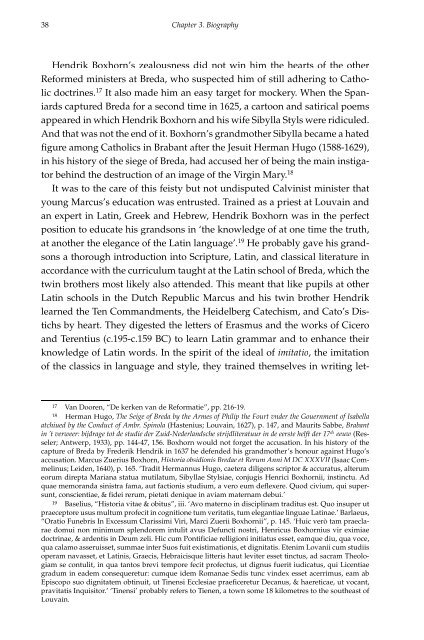historical and political thought in the seventeenth - RePub - Erasmus ...
historical and political thought in the seventeenth - RePub - Erasmus ...
historical and political thought in the seventeenth - RePub - Erasmus ...
You also want an ePaper? Increase the reach of your titles
YUMPU automatically turns print PDFs into web optimized ePapers that Google loves.
38<br />
Chapter 3. Biography<br />
Hendrik Boxhorn’s zealousness did not w<strong>in</strong> him <strong>the</strong> hearts of <strong>the</strong> o<strong>the</strong>r<br />
Reformed m<strong>in</strong>isters at Breda, who suspected him of still adher<strong>in</strong>g to Catholic<br />
doctr<strong>in</strong>es. 17 It also made him an easy target for mockery. When <strong>the</strong> Spaniards<br />
captured Breda for a second time <strong>in</strong> 1625, a cartoon <strong>and</strong> satirical poems<br />
appeared <strong>in</strong> which Hendrik Boxhorn <strong>and</strong> his wife Sibylla Styls were ridiculed.<br />
And that was not <strong>the</strong> end of it. Boxhorn’s gr<strong>and</strong>mo<strong>the</strong>r Sibylla became a hated<br />
figure among Catholics <strong>in</strong> Brabant after <strong>the</strong> Jesuit Herman Hugo (1588-1629),<br />
<strong>in</strong> his history of <strong>the</strong> siege of Breda, had accused her of be<strong>in</strong>g <strong>the</strong> ma<strong>in</strong> <strong>in</strong>stigator<br />
beh<strong>in</strong>d <strong>the</strong> destruction of an image of <strong>the</strong> Virg<strong>in</strong> Mary. 18<br />
It was to <strong>the</strong> care of this feisty but not undisputed Calv<strong>in</strong>ist m<strong>in</strong>ister that<br />
young Marcus’s education was entrusted. Tra<strong>in</strong>ed as a priest at Louva<strong>in</strong> <strong>and</strong><br />
an expert <strong>in</strong> Lat<strong>in</strong>, Greek <strong>and</strong> Hebrew, Hendrik Boxhorn was <strong>in</strong> <strong>the</strong> perfect<br />
position to educate his gr<strong>and</strong>sons <strong>in</strong> ‘<strong>the</strong> knowledge of at one time <strong>the</strong> truth,<br />
at ano<strong>the</strong>r <strong>the</strong> elegance of <strong>the</strong> Lat<strong>in</strong> language’. 19 He probably gave his gr<strong>and</strong>sons<br />
a thorough <strong>in</strong>troduction <strong>in</strong>to Scripture, Lat<strong>in</strong>, <strong>and</strong> classical literature <strong>in</strong><br />
accordance with <strong>the</strong> curriculum taught at <strong>the</strong> Lat<strong>in</strong> school of Breda, which <strong>the</strong><br />
tw<strong>in</strong> bro<strong>the</strong>rs most likely also attended. This meant that like pupils at o<strong>the</strong>r<br />
Lat<strong>in</strong> schools <strong>in</strong> <strong>the</strong> Dutch Republic Marcus <strong>and</strong> his tw<strong>in</strong> bro<strong>the</strong>r Hendrik<br />
learned <strong>the</strong> Ten Comm<strong>and</strong>ments, <strong>the</strong> Heidelberg Catechism, <strong>and</strong> Cato’s Distichs<br />
by heart. They digested <strong>the</strong> letters of <strong>Erasmus</strong> <strong>and</strong> <strong>the</strong> works of Cicero<br />
<strong>and</strong> Terentius (c.195-c.159 BC) to learn Lat<strong>in</strong> grammar <strong>and</strong> to enhance <strong>the</strong>ir<br />
knowledge of Lat<strong>in</strong> words. In <strong>the</strong> spirit of <strong>the</strong> ideal of imitatio, <strong>the</strong> imitation<br />
of <strong>the</strong> classics <strong>in</strong> language <strong>and</strong> style, <strong>the</strong>y tra<strong>in</strong>ed <strong>the</strong>mselves <strong>in</strong> writ<strong>in</strong>g let-<br />
17 Van Dooren, “De kerken van de Reformatie”, pp. 216-19.<br />
18 Herman Hugo, The Seige of Breda by <strong>the</strong> Armes of Philip <strong>the</strong> Fourt vnder <strong>the</strong> Gouernment of Isabella<br />
atchiued by <strong>the</strong> Conduct of Ambr. Sp<strong>in</strong>ola (Hastenius; Louva<strong>in</strong>, 1627), p. 147, <strong>and</strong> Maurits Sabbe, Brabant<br />
<strong>in</strong> ’t verweer: bijdrage tot de studie der Zuid-Nederl<strong>and</strong>sche strijdliteratuur <strong>in</strong> de eerste helft der 17de eeuw (Resseler;<br />
Antwerp, 1933), pp. 144-47, 156. Boxhorn would not forget <strong>the</strong> accusation. In his history of <strong>the</strong><br />
capture of Breda by Frederik Hendrik <strong>in</strong> 1637 he defended his gr<strong>and</strong>mo<strong>the</strong>r’s honour aga<strong>in</strong>st Hugo’s<br />
accusation. Marcus Zuerius Boxhorn, Historia obsidionis Bredae et Rerum Anni M DC XXXVII (Isaac Com-<br />
mel<strong>in</strong>us; Leiden, 1640), p. 165. ‘Tradit Hermannus Hugo, caetera diligens scriptor & accuratus, alterum<br />
eorum direpta Mariana statua mutilatum, Sibyllae Stylsiae, conjugis Henrici Boxhornii, <strong>in</strong>st<strong>in</strong>ctu. Ad<br />
quae memor<strong>and</strong>a s<strong>in</strong>istra fama, aut factionis studium, a vero eum deflexere. Quod civium, qui supersunt,<br />
conscientiae, & fidei rerum, pietati denique <strong>in</strong> aviam maternam debui.’<br />
19 Baselius, “Historia vitae & obitus”, iii. ‘Avo materno <strong>in</strong> discipl<strong>in</strong>am traditus est. Quo <strong>in</strong>super ut<br />
praeceptore usus multum profecit <strong>in</strong> cognitione tum veritatis, tum elegantiae l<strong>in</strong>guae Lat<strong>in</strong>ae.’ Barlaeus,<br />
“Oratio Funebris In Excessum Clarissimi Viri, Marci Zuerii Boxhornii”, p. 145. ‘Huic verò tam praeclarae<br />
domui non m<strong>in</strong>imum splendorem <strong>in</strong>tulit avus Defuncti nostri, Henricus Boxhornius vir eximiae<br />
doctr<strong>in</strong>ae, & ardentis <strong>in</strong> Deum zeli. Hic cum Pontificiae relligioni <strong>in</strong>itiatus esset, eamque diu, qua voce,<br />
qua calamo asseruisset, summae <strong>in</strong>ter Suos fuit existimationis, et dignitatis. Etenim Lovanii cum studiis<br />
operam navasset, et Lat<strong>in</strong>is, Graecis, Hebraicisque litteris haut leviter esset t<strong>in</strong>ctus, ad sacram Theologiam<br />
se contulit, <strong>in</strong> qua tantos brevi tempore fecit profectus, ut dignus fuerit iudicatus, qui Licentiae<br />
gradum <strong>in</strong> eadem consequeretur: cumque idem Romanae Sedis tunc v<strong>in</strong>dex esset acerrimus, eam ab<br />
Episcopo suo dignitatem obt<strong>in</strong>uit, ut T<strong>in</strong>ensi Ecclesiae praeficeretur Decanus, & haereticae, ut vocant,<br />
pravitatis Inquisitor.’ ‘T<strong>in</strong>ensi’ probably refers to Tienen, a town some 18 kilometres to <strong>the</strong> sou<strong>the</strong>ast of<br />
Louva<strong>in</strong>.

















